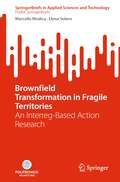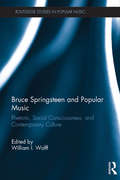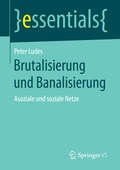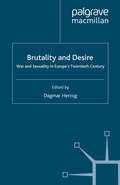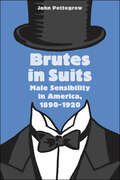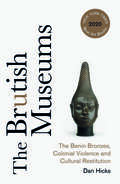- Table View
- List View
Brown Skin, White Masks
by Hamid DabashiThis book is a a critical examination of the role that immigrant intellectuals play in facilitating the global domination of American imperialism.*BR**BR*In his pioneering book about the relationship between race and colonialism, Black Skin, White Masks, Frantz Fanon explored the traumatic consequences of the sense of inferiority that colonised people felt. Brown Skin, White Masks picks up where Fanon left off, and extends Fanon's insights as they apply to today's world.*BR**BR*Dabashi shows how intellectuals who migrate to the West are often used by the imperial powers to misrepresent their home countries. Just as many Iraqi exiles were used to justify the invasion of Iraq, Dabashi demonstrates that this is a common phenomenon, and examines why and how so many immigrant intellectuals help to sustain imperialism.
Brown Skin, White Masks (The\islamic Mediterranean Ser.)
by Hamid DabashiThis book is a a critical examination of the role that immigrant intellectuals play in facilitating the global domination of American imperialism.*BR**BR*In his pioneering book about the relationship between race and colonialism, Black Skin, White Masks, Frantz Fanon explored the traumatic consequences of the sense of inferiority that colonised people felt. Brown Skin, White Masks picks up where Fanon left off, and extends Fanon's insights as they apply to today's world.*BR**BR*Dabashi shows how intellectuals who migrate to the West are often used by the imperial powers to misrepresent their home countries. Just as many Iraqi exiles were used to justify the invasion of Iraq, Dabashi demonstrates that this is a common phenomenon, and examines why and how so many immigrant intellectuals help to sustain imperialism.
Browned Off and Bloody-Minded: The British Soldier Goes to War 1939-1945
by Alan AllportMore than three-and-a-half million men served in the British Army during the Second World War, the vast majority of them civilians who had never expected to become soldiers and had little idea what military life, with all its strange rituals, discomforts, and dangers, was going to be like. Alan Allport’s rich and luminous social history examines the experience of the greatest and most terrible war in history from the perspective of these ordinary, extraordinary men, who were plucked from their peacetime families and workplaces and sent to fight for King and Country. Allport chronicles the huge diversity of their wartime trajectories, tracing how soldiers responded to and were shaped by their years with the British Army, and how that army, however reluctantly, had to accommodate itself to them. Touching on issues of class, sex, crime, trauma, and national identity, through a colorful multitude of fresh individual perspectives, the book provides an enlightening, deeply moving perspective on how a generation of very modern-minded young men responded to the challenges of a brutal and disorienting conflict.
Brownfield Transformation in Fragile Territories: An Interreg-Based Action Research (SpringerBriefs in Applied Sciences and Technology)
by Marcello Modica Elena SoleroThis book presents and critically evaluates the results of a European territorial cooperation project addressing the planning challenge of brownfield transformation in fragile territories. Set against the backdrop of the current scenario of deindustrialisation in the European Alps, the book describes how to read and interpret the spatial condition of industrial brownfields in peripheral mountain areas as complex transformation sites. Through key theoretical references, well-documented experiences and field activities, the book explores and advances an innovative methodology of design-based participatory planning conceived specifically for fragile socioeconomic and environmental contexts. The empirical basis for such a methodological exploration is provided by four pilot sites distributed between Austria, Italy, France and Slovenia, identified in the cooperation project as highly representative and recurring situations. The book includes a comparative review of the work carried out for the pilot sites, as well as the planning outcomes generated, providing a clear and operative reference for scholars, professionals and public officers called to face similar experiences.
The Browning of the New South
by Jennifer A. JonesStudies of immigration to the United States have traditionally focused on a few key states and urban centers, but recent shifts in nonwhite settlement mean that these studies no longer paint the whole picture. Many Latino newcomers are flocking to places like the Southeast, where typically few such immigrants have settled, resulting in rapidly redrawn communities. In this historic moment, Jennifer Jones brings forth an ethnographic look at changing racial identities in one Southern city: Winston-Salem, North Carolina. This city turns out to be a natural experiment in race relations, having quickly shifted in the past few decades from a neatly black and white community to a triracial one. Jones tells the story of contemporary Winston-Salem through the eyes of its new Latino residents, revealing untold narratives of inclusion, exclusion, and interracial alliances. The Browning of the New South reveals how one community’s racial realignments mirror and anticipate the future of national politics.
The Browning of the New South
by Jennifer A. JonesStudies of immigration to the United States have traditionally focused on a few key states and urban centers, but recent shifts in nonwhite settlement mean that these studies no longer paint the whole picture. Many Latino newcomers are flocking to places like the Southeast, where typically few such immigrants have settled, resulting in rapidly redrawn communities. In this historic moment, Jennifer Jones brings forth an ethnographic look at changing racial identities in one Southern city: Winston-Salem, North Carolina. This city turns out to be a natural experiment in race relations, having quickly shifted in the past few decades from a neatly black and white community to a triracial one. Jones tells the story of contemporary Winston-Salem through the eyes of its new Latino residents, revealing untold narratives of inclusion, exclusion, and interracial alliances. The Browning of the New South reveals how one community’s racial realignments mirror and anticipate the future of national politics.
The Browning of the New South
by Jennifer A. JonesStudies of immigration to the United States have traditionally focused on a few key states and urban centers, but recent shifts in nonwhite settlement mean that these studies no longer paint the whole picture. Many Latino newcomers are flocking to places like the Southeast, where typically few such immigrants have settled, resulting in rapidly redrawn communities. In this historic moment, Jennifer Jones brings forth an ethnographic look at changing racial identities in one Southern city: Winston-Salem, North Carolina. This city turns out to be a natural experiment in race relations, having quickly shifted in the past few decades from a neatly black and white community to a triracial one. Jones tells the story of contemporary Winston-Salem through the eyes of its new Latino residents, revealing untold narratives of inclusion, exclusion, and interracial alliances. The Browning of the New South reveals how one community’s racial realignments mirror and anticipate the future of national politics.
The Browning of the New South
by Jennifer A. JonesStudies of immigration to the United States have traditionally focused on a few key states and urban centers, but recent shifts in nonwhite settlement mean that these studies no longer paint the whole picture. Many Latino newcomers are flocking to places like the Southeast, where typically few such immigrants have settled, resulting in rapidly redrawn communities. In this historic moment, Jennifer Jones brings forth an ethnographic look at changing racial identities in one Southern city: Winston-Salem, North Carolina. This city turns out to be a natural experiment in race relations, having quickly shifted in the past few decades from a neatly black and white community to a triracial one. Jones tells the story of contemporary Winston-Salem through the eyes of its new Latino residents, revealing untold narratives of inclusion, exclusion, and interracial alliances. The Browning of the New South reveals how one community’s racial realignments mirror and anticipate the future of national politics.
The Browning of the New South
by Jennifer A. JonesStudies of immigration to the United States have traditionally focused on a few key states and urban centers, but recent shifts in nonwhite settlement mean that these studies no longer paint the whole picture. Many Latino newcomers are flocking to places like the Southeast, where typically few such immigrants have settled, resulting in rapidly redrawn communities. In this historic moment, Jennifer Jones brings forth an ethnographic look at changing racial identities in one Southern city: Winston-Salem, North Carolina. This city turns out to be a natural experiment in race relations, having quickly shifted in the past few decades from a neatly black and white community to a triracial one. Jones tells the story of contemporary Winston-Salem through the eyes of its new Latino residents, revealing untold narratives of inclusion, exclusion, and interracial alliances. The Browning of the New South reveals how one community’s racial realignments mirror and anticipate the future of national politics.
The Browning of the New South
by Jennifer A. JonesStudies of immigration to the United States have traditionally focused on a few key states and urban centers, but recent shifts in nonwhite settlement mean that these studies no longer paint the whole picture. Many Latino newcomers are flocking to places like the Southeast, where typically few such immigrants have settled, resulting in rapidly redrawn communities. In this historic moment, Jennifer Jones brings forth an ethnographic look at changing racial identities in one Southern city: Winston-Salem, North Carolina. This city turns out to be a natural experiment in race relations, having quickly shifted in the past few decades from a neatly black and white community to a triracial one. Jones tells the story of contemporary Winston-Salem through the eyes of its new Latino residents, revealing untold narratives of inclusion, exclusion, and interracial alliances. The Browning of the New South reveals how one community’s racial realignments mirror and anticipate the future of national politics.
Brownsville, Brooklyn: Blacks, Jews, and the Changing Face of the Ghetto (Historical Studies of Urban America)
by Wendell E. PritchettFrom its founding in the late 1800s through the 1950s, Brownsville, a section of eastern Brooklyn, was a white, predominantly Jewish, working-class neighborhood. The famous New York district nurtured the aspirations of thousands of upwardly mobile Americans while the infamous gangsters of Murder, Incorporated controlled its streets. But during the 1960s, Brownsville was stigmatized as a black and Latino ghetto, a neighborhood with one of the city's highest crime rates. Home to the largest concentration of public housing units in the city, Brownsville came to be viewed as emblematic of urban decline. And yet, at the same time, the neighborhood still supported a wide variety of grass-roots movements for social change. The story of these two different, but in many ways similar, Brownsvilles is compellingly told in this probing new work. Focusing on the interaction of Brownsville residents with New York's political and institutional elites, Wendell Pritchett shows how the profound economic and social changes of post-World War II America affected the area. He covers a number of pivotal episodes in Brownsville's history as well: the rise and fall of interracial organizations, the struggles to deal with deteriorating housing, and the battles over local schools that culminated in the famous 1968 Teachers Strike. Far from just a cautionary tale of failed policies and institutional neglect, the story of Brownsville's transformation, he finds, is one of mutual struggle and frustrated cooperation among whites, blacks, and Latinos. Ultimately, Brownsville, Brooklyn reminds us how working-class neighborhoods have played, and continue to play, a central role in American history. It is a story that needs to be read by all those concerned with the many challenges facing America's cities today.
Bruce Arrigo: Activism, Crime, and Justice (Palgrave Pioneers in Criminology)
by David PolizziThis book examines various aspects of the work of Bruce Arrigo related to therapeutic jurisprudence, criminal justice ethics, and the place of critical theory in criminology and related fields. Arrigo’s work spans over thirty years and during that time has been an important voice in the practical and theoretical application of post-modern and critical theoretical approaches to mental illness, the practice of forensic psychology, and a wide variety of critical reflection concerning incarceration, rehabilitation, and the ethical practice within the criminal justice system. Each individual contributor offers their own perspective on his work and its specific influence on the topic under discussion. This book speaks to academics focused on the application of critical criminological theory within a variety of disciplinary contexts. These include forensic psychology, psychological jurisprudence, criminal justice ethics, and philosophically based critiques of the law and mental health and criminal justice activism.
Bruce Springsteen and Popular Music: Rhetoric, Social Consciousness, and Contemporary Culture (Routledge Studies in Popular Music)
by William I. WolffThis interdisciplinary volume enters the scholarly conversation about Bruce Springsteen at the moment when he has reinforced his status of global superstar and achieved the status of social critic. Covering musical and cultural developments, chapters primarily consider work Springsteen has released since 9/11—that is, released during a period of continued global unrest, economic upheaval, and social change—under the headings Politics, Fear and Society; Gender and Sexual Identity; and Toward a Rhetoric of Springsteen. The collection engages Springsteen and popular music as his contemporary work is just beginning to be understood in terms of its impact on popular culture and music, applying new areas of inquiry to Springsteen and putting Springsteen fan writing within the same binding as academic writing to show how together they create a more nuanced understanding of an artist. Established and emerging Springsteen scholars approach work from disciplines including rhetoric and composition, historical musicology, labor studies, American history, literature, communications, sociology, theology, and government. Offering context, critique, and expansive understanding of Springsteen and his work, this book contributes to Springsteen scholarship and the study of popular music by showing Springsteen’s broadening academic appeal as well as his escalating legacy on new musicians, social consciousness, and contemporary culture.
Bruce Springsteen and Popular Music: Rhetoric, Social Consciousness, and Contemporary Culture (Routledge Studies in Popular Music)
by William I. WolffThis interdisciplinary volume enters the scholarly conversation about Bruce Springsteen at the moment when he has reinforced his status of global superstar and achieved the status of social critic. Covering musical and cultural developments, chapters primarily consider work Springsteen has released since 9/11—that is, released during a period of continued global unrest, economic upheaval, and social change—under the headings Politics, Fear and Society; Gender and Sexual Identity; and Toward a Rhetoric of Springsteen. The collection engages Springsteen and popular music as his contemporary work is just beginning to be understood in terms of its impact on popular culture and music, applying new areas of inquiry to Springsteen and putting Springsteen fan writing within the same binding as academic writing to show how together they create a more nuanced understanding of an artist. Established and emerging Springsteen scholars approach work from disciplines including rhetoric and composition, historical musicology, labor studies, American history, literature, communications, sociology, theology, and government. Offering context, critique, and expansive understanding of Springsteen and his work, this book contributes to Springsteen scholarship and the study of popular music by showing Springsteen’s broadening academic appeal as well as his escalating legacy on new musicians, social consciousness, and contemporary culture.
Brücke, Switchboard, Theke - Working Girls vor Ort (Edition Medienwissenschaft #85)
by Verena MundIn Unter den Brücken sieht man die Frauen oben auf den Brücken. Am Fenster ihres Ullstein-Büros imaginiert Vicki Baum die Idee einer Telefonistin vor der Schaltwand und transferiert so ihren Roman in ein Theaterstück. Baum, die Telefonistin und die Frauen am Brückengeländer kehren alle den Rücken zum übrigen Raum. Und genauso ausgerichtet sitzen auch die Studierenden bei den berühmten Sit-ins der US-Bürgerrechtsbewegung am Lunch Counter. Kaum bekannt hingegen ist der Kampf der zweiten Frauenbewegung um den Zugang zu Bars, der weniger an der Theke als vor Gericht ausgefochten wurde. Verena Mund untersucht diese Orte des Arbeitsalltags in Bildern, Filmen und Texten sowie ihre Implikationen für Handlungsmacht.
Brunei - History, Islam, Society and Contemporary Issues (Routledge Contemporary Southeast Asia Series)
by Ooi Keat GinBrunei, although a relatively small state, is disproportionately important on account of its rich resource base. In addition, in recent years the country has endeavoured to play a greater role in regional affairs, especially through ASEAN, holding the chair of the organisation in 2013, and also beyond the region, fostering diplomatic, political, economic and educational ties with many nations. This book presents much new research and new thinking on a wide range of issues concerning Brunei largely drawn from Bruneian academics. Subjects covered include Brunei’s rich history – the sultanate formerly had much more extensive territories and was a key player in regional affairs; the country’s economy, politics, society and ethnicities; and resource issues and international relations.
Brunei - History, Islam, Society and Contemporary Issues (Routledge Contemporary Southeast Asia Series)
by Ooi Keat GinBrunei, although a relatively small state, is disproportionately important on account of its rich resource base. In addition, in recent years the country has endeavoured to play a greater role in regional affairs, especially through ASEAN, holding the chair of the organisation in 2013, and also beyond the region, fostering diplomatic, political, economic and educational ties with many nations. This book presents much new research and new thinking on a wide range of issues concerning Brunei largely drawn from Bruneian academics. Subjects covered include Brunei’s rich history – the sultanate formerly had much more extensive territories and was a key player in regional affairs; the country’s economy, politics, society and ethnicities; and resource issues and international relations.
Bruno Latour in the Semiotic Turn: An Inquiry into the Networks of Meaning (SpringerBriefs in Sociology)
by Paolo PeveriniThis open access book highlights the link between Bruno Latour's works and the semiotic perspective on social phenomena analysis. It identifies and relaunches a dialogue that was as heated as it was fruitful, but still little recognized within the social sciences. It asks why the theory of signification has so far been only sporadically acknowledged in literature derived from Latour's work. Starting from these premises, the book explores two interrelated dimensions, the initial one of a "semiotics for Latour", which looks at concepts from semiotics in Latour's study of social phenomena, and extensively for the first time, a symmetrical one of a "Latour for semiotics," accounting for the impact of Latourian inquiry on contemporary semiotic research. The book offers a novel perspective on Bruno Latour's work by addressing a wide readership, including those interested in Latour’s approach, actor-network theory, semiotics, and the social sciences. The English translation of this book from the Italian original manuscript was done with the help of artificial intelligence, then revised technically and linguistically by the author in collaboration with a professional translator.
Brushed in Light: Calligraphy in East Asian Cinema
by Abé Markus NornesDrawing on a millennia of calligraphy theory and history, Brushed in Light examines how the brushed word appears in films and in film cultures of Korea, Japan, Taiwan, Hong Kong, and PRC cinemas. This includes silent era intertitles, subtitles, title frames, letters, graffiti, end titles, and props. Markus Nornes also looks at the role of calligraphy in film culture at large, from gifts to correspondence to advertising. The book begins with a historical dimension, tracking how calligraphy is initially used in early cinema and how it is continually rearticulated by transforming conventions and the integration of new technologies. These chapters ask how calligraphy creates new meaning in cinema and demonstrate how calligraphy, cinematography, and acting work together in a single film. The last part of the book moves to other regions of theory. Nornes explores the cinematization of the handwritten word and explores how calligraphers understand their own work.
Brustkrebs: Der Diagnoseprozess und die laute Sprachlosigkeit der Medizin Eine soziologische Untersuchung
by Silke KirschningDie Diagnose Brustkrebs zu stellen, ist für Ärztinnen und Ärzte nicht nur aus medizinischer Sicht schwierig. Doch wie gehen Ärztinnen und Ärzte um mit ihrer eigenen Betroffenheit, ihren Emotionen? Inwieweit ist im Ablauf der hochtechnisierten Krankenhäuser Raum dafür, auf die Seelenlage der Betroffenen einzugehen? Wie gehen betroffene Frauen damit um, wenn bei ihnen ein Verdacht auf Brustkrebs entsteht? Die Interviews mit Ärztinnen und Ärzten zeigen die Schwierigkeiten und Ambivalenzen in der Auseinandersetzung mit Patientinnen, die an Brustkrebs erkrankt sind. Die Schwerpunkte innerhalb der medizinischen Diagnostik und Therapie werden dabei genauso sichtbar wie die Rationalisierungs-Mechanismen, die eingesetzt werden (müssen?), um über eine derart schwere, möglicherweise unheilbare oder tödliche Krankheit zu sprechen, zumal die Operationsmöglichkeiten, die oftmals im Rahmen einer Therapie eingesetzt werden, das äußere Erscheinungsbild der betroffenen Frauen stark und folgenreich verändert. Der Bewusstwerdungsprozess der betroffenen Frauen wird in Interviews rekonstruiert und als Aneignungsarbeit bezeichnet. Die unterschiedlichen Kommunikationsebenen zwischen Medizin und den Betroffenen werden dabei deutlich. Das Buch bleibt nicht stehen bei der Darstellung des Ist-Zustandes sondern zeigt Ansätze auf, wie die Kommunikation zwischen ÄrztInnen und PatientInnen aus der heutigen Schieflage zu einem für beide Seiten positiveren Verständnis geführt werden kann.
Brutalisierung und Banalisierung: Asoziale und soziale Netze (essentials)
by Peter LudesPeter Ludes entlarvt Brutalisierung und Banalisierung in kollektiven Mythen – für eine Emanzipation der Sinne im Zeitalter ihrer technischen Vereinnahmung. Denn Informations- und Kommunikationstechnologien dienen nicht nur der Ausweitung von Kommunikation, sondern auch als Kampfmittel. Insoweit sie aufgrund ihrer leicht zugänglichen, scheinbar kostenlosen Verbreitung als relativ natürliche Weltbedingungen erlebt werden, konstituieren sie neue Mythen der unbegrenzten, freien Kommunikation. Welche Perspektiven und Praktiken werden aber wie vorgegeben und formatiert? Wie wird das komplexe und widersprüchliche Zusammenspiel und Gegeneinander von fiktiven Behauptungen und verdrängten ‚Tat-Sachen‘ zu einem neuen Problem? Es geht zum Schluss um unterschiedlich vernetzte lokale Kontakt- und globale virtuelle Machtzonen, die hier symbolisch aufgehoben werden mit Abrechnungen für die acht reichsten Männer der Erde.Der Autor Dr. Peter Ludes, PhD (USA), habilitierter Soziologe, apl. Professor für Kultur- und Medienwissenschaft in Siegen. Professor für Massenkommunikation an der Jacobs University Bremen 2002-2017, Gastprofessor an der Universität Köln.
Brutality and Desire: War and Sexuality in Europe's Twentieth Century (Genders and Sexualities in History)
by D. HerzogTracing sexual violence in Europe's twentieth century from the Armenian genocide to Auschwitz and Algeria to Bosnia, this pathbreaking volume expands military history to include the realm of sexuality. Examining both stories of consensual romance and of intimate brutality, it also contributes significant new insights to the history of sexuality.
Brute Reality: Power, Discourse and the Mediation of War
by Stuart PriceBrute Reality provides an authoritative analysis of those formal attempts, made by prominent social actors, to present a rationale for the existence and exercise of coercive power. The 'War on Terror' and its associated campaigns are presented as an aggressive attempt to assert the contradictory interests of a trans-national elite.*BR**BR*The period chosen to illustrate the key characteristics of this enterprise, extends from the state of 'war' created after the September 11th attacks, to the strategic adjustments begun during the nadir of the Iraq adventure; it also includes reference to the modifications in policy carried out under the auspices of the Obama Presidency. The book provides a critical insight into a number of influential structures that have helped to shape contemporary attitudes to warfare, and contains a wealth of transcripts and media sources, from Channel Four's coverage of September 11th, to the rhetorical pronouncements of leading politicians. *BR**BR*Brute Reality represents a significant addition to the existing literature on representations of the 'War on Terror' in the mass media, and will have a strong appeal to keen students of media, communication, cultural and American studies.
Brutes in Suits: Male Sensibility in America, 1890–1920 (Gender Relations in the American Experience)
by John PettegrewAre men truly predisposed to violence and aggression? Is it the biological fate of males to struggle for domination over women and vie against one another endlessly? These and related queries have long vexed philosophers, social scientists, and other students of human behavior. In Brutes in Suits, historian John Pettegrew examines theoretical writings and cultural traditions in the United States to find that, Darwinian arguments to the contrary, masculine aggression can be interpreted as a modern strategy for taking power. Drawing ideas from varied and at times seemingly contradictory sources, Pettegrew argues that traditionally held beliefs about masculinity developed largely through language and cultural habit—and that these same tools can be employed to break through the myth that brutishness is an inherently male trait.A major re-synthesis of late nineteenth- and early twentieth-century manhood, Brutes in Suits develops ambitious lines of research into the social science of sexual difference and professional history’s celebration of rugged individualism; the hunting-and-killing genre of popular men’s literature; that master text of hypermasculinity: college football; military culture, war making, and finding pleasure in killing; and patriarchy, sexual jealousy, and the law. This timely assessment of the evolution of masculine culture will be welcomed and debated by social and intellectual historians for years to come.
The Brutish Museums: The Benin Bronzes, Colonial Violence and Cultural Restitution
by Dan HicksWalk into any European museum today and you will see the curated spoils of Empire. They sit behind plate glass: dignified, tastefully lit. Accompanying pieces of card offer a name, date and place of origin. They do not mention that the objects are all stolen. Few artefacts embody this history of rapacious and extractive colonialism better than the Benin Bronzes - a collection of thousands of metal plaques and sculptures depicting the history of the Royal Court of the Obas of Benin City, Nigeria. Pillaged during a British naval attack in 1897, the loot was passed on to Queen Victoria, the British Museum and countless private collections. The story of the Benin Bronzes sits at the heart of a heated debate about cultural restitution, repatriation and the decolonisation of museums. In The Brutish Museum, Dan Hicks makes a powerful case for the urgent return of such objects, as part of a wider project of addressing the outstanding debt of colonialism.



